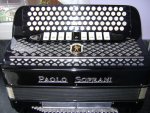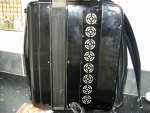T
Tony M
Guest
Hi, all.
Just got a new box (well, new to me, anyway) - Paolo Soprani 120 bass CBA.
I'm very pleased with it, it came at a good price and is in nice condition inside and out. However, I have a critical eye, and have spotted a hairline crack on one corner of the treble end bodywork, running down the corner to the point where it meets the bellows. No air leakage, no "movement" in the crack and no effect on playing quality - it really is a very fine crack and almost invisible. On the inside, it's the same story - but the crack is clearly there, nontheless.
I could leave it alone (if it ain't broke . . .) - however, my usual approach is that if it won't get better, fixing it might be a good move.
I've thought about gluing it:
I could use a thin mix of old-fashioned pearl glue (hide glue, if you like), which would be preferable from the perspective of being removable in the future. Thinned PVA might be another alternative - but the crack is so fine that I'm not convinced that either would penetrate sufficiently to achieve a good joint. The crack is pretty tightly closed, and there seems no point in trying to force it open to insert glue.
The only thing I can think of that is likely to penetrate is thin superglue. In general, I prefer to avoid the stuff, because its rather "one shot" - once it's on, there's no way to unglue it if the need arises.
So, I thought I'd seek a wider view and throw it open for discussion here.
Thoughts welcome.
Tony M.
Just got a new box (well, new to me, anyway) - Paolo Soprani 120 bass CBA.
I'm very pleased with it, it came at a good price and is in nice condition inside and out. However, I have a critical eye, and have spotted a hairline crack on one corner of the treble end bodywork, running down the corner to the point where it meets the bellows. No air leakage, no "movement" in the crack and no effect on playing quality - it really is a very fine crack and almost invisible. On the inside, it's the same story - but the crack is clearly there, nontheless.
I could leave it alone (if it ain't broke . . .) - however, my usual approach is that if it won't get better, fixing it might be a good move.
I've thought about gluing it:
I could use a thin mix of old-fashioned pearl glue (hide glue, if you like), which would be preferable from the perspective of being removable in the future. Thinned PVA might be another alternative - but the crack is so fine that I'm not convinced that either would penetrate sufficiently to achieve a good joint. The crack is pretty tightly closed, and there seems no point in trying to force it open to insert glue.
The only thing I can think of that is likely to penetrate is thin superglue. In general, I prefer to avoid the stuff, because its rather "one shot" - once it's on, there's no way to unglue it if the need arises.
So, I thought I'd seek a wider view and throw it open for discussion here.
Thoughts welcome.
Tony M.





